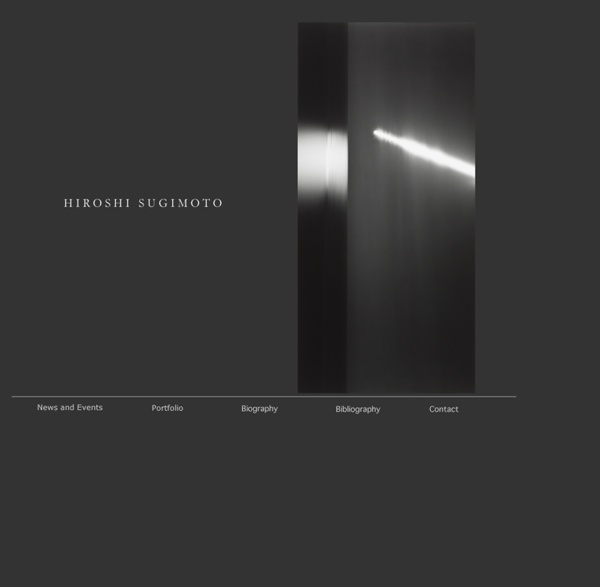



faustine ferhmin | Perception Park faustine ferhmin faustine ferhmin, dans la série intitulée , photographie l’espace. le terme fait signe vers un temps plus vaste que celui de l’histoire humaine : il signifie «révolution, bouleversement» (cuti) de l’«espace-temps» ou de la «terre» (pacha). cette notion centrale dans la pensée cosmogonique inca désigne les cycles réguliers de destruction et de recréation cataclysmiques du monde. même si les ruines sont présentes sur ces photographies, prises au pérou, ce n’est pas une approche d’historienne qu’adopte faustine ferhmin : chaque photographie est plutôt une confrontation avec une immensité abrupte, dont les spécificités géologiques participent à une véritable architecture de l’espace. {*style:<i> </i>*}{*style:<i> </i>*}{*style:<i> </i>*}{*style:<i> </i>*}{*style:<i> </i>*}{*style:<i> </i>*}{*style:<i> </i>*} faustine ferhmin est née en 1980, elle vit et travaille à paris. www.faustine-ferhmin.com
Nobuyoshi Araki Pictures Diese Seite drucken Share | Commenti Pubblica un commento testuale. Verificheremo l'idoneità del contenuto e provvederemo alla... Главным субъектом в творчестве Нобуеси Араки (Nobuyoshi Araki) является человек, рассказывающий о... STAROBA. KRÁSA PRÍRODY. Exhibition Opening: Wednesday, September 7th, 2011, 7 - 9 pm in Singapore Ooi Botos and Galerie... '); This book accompanied the 2008 exhibition of large kinbaku (a Japanese style of sexual bondage)... Der Fotograf Nobuyoshi Araki | © Junko Kimura/Getty Images ZEITmagazin: Herr Araki, für Ihr Buch... © Nobuyoshi Araki ARAKINEMA-Paris est un projet unique et spécialement conçu pour le Palais de Tokyo... A opäť žena. image property of Nobuyoshi Araki i had the great pleasure of previewing the new arakimentari... FESTIVAL V EDITION - APRIL/MAY 2006 Festival Internazionale di Roma Araki Nobuyoshi But visiting this bar is to merely sip stale water at the grand banquet of... По имени Nobuyoshi Araki Prace Nobuyoshi Araki w galerii Kamela Mennour'a.
YVON LAMBERT Opening on Friday March 14th, 2014 No Drones March 14th – April 19th Louise Lawler, » Hand On Her Back », 1997-1998-2014 Woman With Sombrero Jill Magid, Women with Sombrero Shining Living François Deladerrière Galerie Perrotin Adam Jeppesen site national | design & arts appliqués Cyrille Weiner Accueil - Bibliographie eNq1V8Fy2jAQvfcrPL5jmwYS6JhkWpq0zCTTNMC0t4xsyyCqSM5KxtCvr2xMYjKYEhmdsC2xb3e1+/bJv1o9UWuJQRDOBnbb8WwLs5BHhM0G9nRy0+rZV5fWB3+Blqi679zxHjtd2wopEmJg58tOgBETzu+7269YWcBgqz9aPg8WOJQ7G1NJqPMdifkdSopNlr/kJLKesJzzaGAnqdx8tnwhQblymXCQiA6RxDMOa98tP+/uaT/2+xe9s51V380tH4VBxC8Of0SCQnwPfEkiHO0HihEVWBclzqJ7JOcjFvP91t0yjo4bkIASPgOUzIk2XraN6VDSul39pE0FhlvEZmZzNuRM4pXMU1eXtrxECNUP5L6oMYNhpHmmeIhozVnE8Dgd6xoH/DzGsKT4UI4iIhKK1s5CJA1wfqYY1uPidT8OiQbbItaFCZDAU6D77c+lTD65bpZlDgpbCQIinBi2FeA2CM14mQEWPAXFMLUIi/BJnJgDFLMRFvFMGChq1TcIkFrHoNjcYPeEKQBm8qgZ0GnKAlsUg/EQMWI3oOrtRxyTOnqWkGoDJJVzeWP9qJlcj1Dt9F3LagUBoPWOaaqmg7PhC9uimM3kXEmIF1sljKpQvBrY3uv3w6dabHjNRvFWYG+dr6z57iZijekGpifCkKdM1tWz/jwgYihXZRkTLAwGgRZo9YCfRzW2P6tl5Ypsea12x/vY756deb3OxXlDxVHMUaPt+VChaqNAXzazzrTyQHXjOgZtiinI8gAV97y2Nt9Xy3c/RINBnx/qBNR9hSqMmpS7KEkocTMcqAfR2sqLl9+TzugkDd54wVJK3XeftKZmMqA6VJYVLaRYyOnD6LCaOoUwVZeEemGqlUtl8egAzOSv5qaoFY2SNqnyKkRSXeFN6jTTEnqzst/2t+tJg4H56rlRvh/uKlmDWGVblRfD00tM1SH/v3TmrdFs2JcSyWCi/nJWo8A3TdNA5F+/392KXPXdXEKrh3/wHUZX
neuigkeiten : ester vonplon Carpenters Workshop Gallery | Exhibitions Established in 2005 by Parisian entrepreneurs and art devotees Loic Le Gaillard and Julien Lombrail, Carpenters Workshop Gallery is known for its discovery of bold and iconic design-art. Like many of the artists it fosters, the gallery takes a young, fresh and dynamic approach, primarily following its own aesthetic. They exhibit unique and limited edition works both by emerging and established artists, and designers. Carpenters Workshop GaIlery is committed to making ambitious ideas work, through its daring and integrity it has cultivated strong relationships with the artists it works with.
Sophie Ristelhueber Sophie Ristelhueber est une artiste contemporaine dont le travail me tient à cœur. Ses photographies me parlent et touchent des territoires intimes de ma conscience. Je suppose qu’il en est de même pour beaucoup de personnes qui aiment porter un regard sur l’indicible… Territoires est bien le mot qu’il faut employer avec cette artiste qui aime à promener son objectif aux quatre coins de la planète, avec une préférence marquée pour certaines zones de conflit du Proche et Moyen Orient. Sophie Ristelhueber, Beyrouth, Photographies, 1984 Vous avez aussi peut-être été frappé par la violence « esthétique » de la série Every One, soit une série de 14 clichés en noir et blanc réalisés dans un hôpital parisien. Sophie Ristelhueber, Every One #14, 1994 Et puis vous avez été frappé par cette série de photographies réalisées en plein désert Koweitien : Fait. Sophie Ristelhueber, Fait #46, 1992 Pour autant, à ces démonstrations spectaculaires, je choisis le territoire de l’intime.